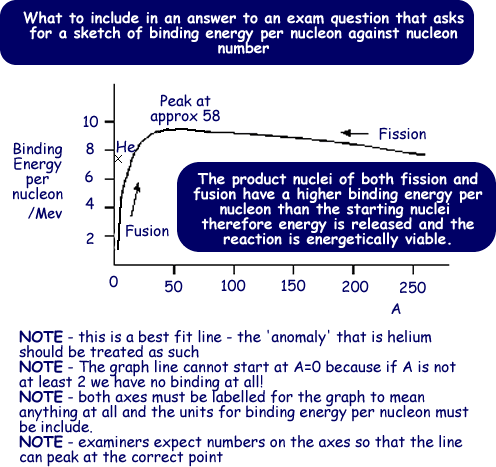Nuclear Binding Energy and Mass Difference Nuclear binding energy is the energy required to break up the nucleus into its separate nucleons OR this can be expressed as the energy released when the nucleus is formed from separate nucleons. Binding energy is equal to the decrease in potential nuclear energy of the nucleons when they come together. This is equivalent to the work done on the nucleons by the strong nuclear force. Binding energy is the energy associated with the strong force that holds the nucleons together. The mass of a nucleus is less than the mass of the individual nucleons that make up that nucleus. The mass difference (Δm) between the two is equivalent to the binding energy of the nucleus. Mass differenceThe relationship between binding energy and mass difference is given by Einstein's equation: E b = Δm c2On the AQA board data sheet there is a conversion factor from mass (u) to energy in MeV - this saves you converting the mass into kilogram and then using E = mc2 to work out the energy in joules and then convert the energy in joules to MeV). You MUST use that conversion factor in calculations relating to binding energy as it is given to 4 significant figures, whereas the speed of light is only given to 3 on your data sheet and is not to the degree of precision needed for the calculations you have to perform.
Mass difference of a nucleusLet Δm be the difference between mass of nucleus and the total mass of the individual nucleons that make it up. We can express this as an equation (that is NOT on your data sheet!) Δm = Zmp + (A – Z) mn – m nucleuswhere:
Binding Energy Per Nucleon
The binding energy per nucleon for helium-4 is = 28.38 MeV/4 = 7.1 MeV- this is not where we would expect it to be on the general curve.
Nuclei larger than iron undergo nuclear fissionIf we look at large nuclei (much greater than iron), we find that the further to the right on the graph we go (going to greater nucleon numbers) the less stable the nuclei. This is because the binding energy per nucleon is getting less. These nuclei undergo fission and split to produce products with higher binding energy per nucleaon values - more stable products. Nuclei smaller than iron undergo fusionIf we look at nuclei of much smaller mass than iron we find they have a lower binding energy per nucleon. Therefore when these fuse to produce a heavier nucleus it is more stable - fusion can be shown to be energetically viable from the above graph. The product nucleus has a higher binding energy pernucleon than the two that fuse to form it. It is therefore more stable than its constituents.
|
Follow me...
|








